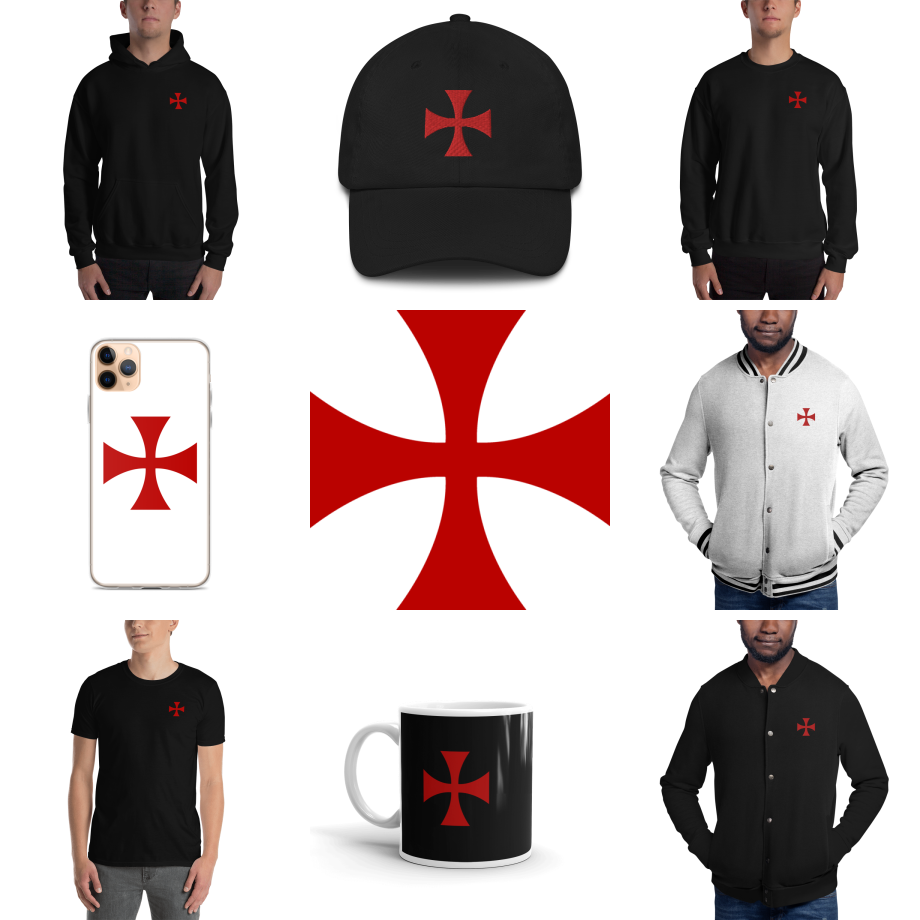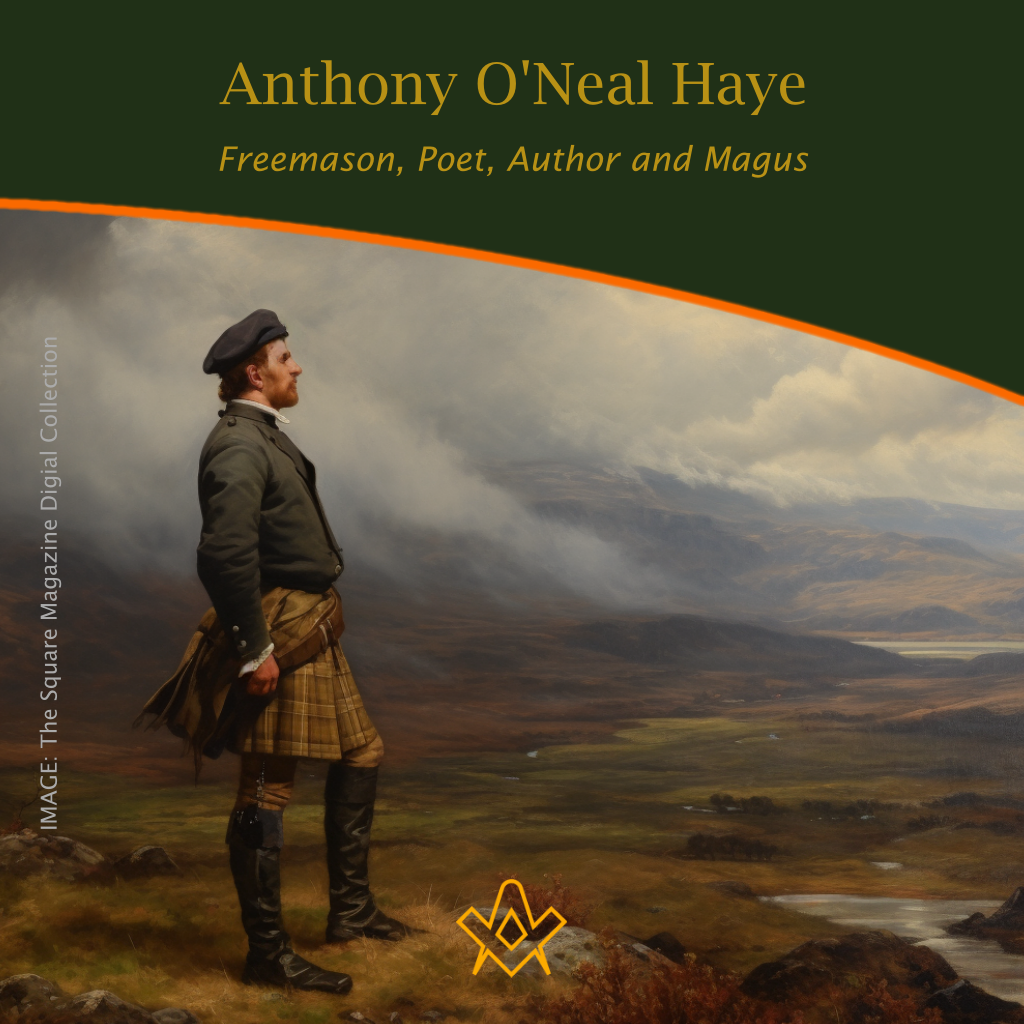There have been many influential and illustrious Scottish Freemasons throughout the centuries, ever since speculative Craft Masonry first took shape and cast its wise and benign influence over Scottish society.
Indeed, there are that many, it is probably not possible to do each and every one of them justice, and perhaps the only time we ever hear of them is when a Brother, or some other interested outsider decides to make them the subject of their research interest.
Anthony O’Neal Haye is one such Freemason of whom very little, if anything at all, has been written, which is a great pity, because as well as being a senior and highly respected Freemason in his time, he was also a respected journalist and author who wrote a number of history books and books of his own verse, and indeed, for a time, was Poet Laureate of Lodge Canongate Kilwinning No. 2 in Edinburgh.
It is fair to say that his Masonic and literary interests often went hand-in-glove, as his poetry was published by his Lodge or the Grand Lodge of Scotland.
His history books also centred on the history of the Knights Templar, and he himself was a member of Lothian Preceptory No. 4 of that Masonic Order.
Magus
This writer became aware of Haye when reading an encyclopaedic entry concerning the Societas Rosicruciana in Civitatibus Foederatis by the Grand Archivist of that society; in which he writes:
In 1878, a group of senior U.S. Masons (Daniel Sutter, and Charles W. Parker) led by Charles E. Meyer (1839-1908) of Pennsylvania travelled to England and on July 25th, 1878 were initiated into the grade of Zelator at Yorkshire College at Sheffield.
They applied for a Charter, but getting no response, turned to Scotland and received a Charter from the College in Edinburgh in 1879.
Scotland’s Society is actually the oldest as Walter Spencer is recorded as having been initiated into the SRIS by Anthony O’Neal Haye in 1857 and there are documents in the SRIA Archives that show that both Robert Wentworth Little and William J. Hughan were initiated in 1866 and 1867 by Anthony O’Neal Haye, Magus Max; Ros. Soc. Scot. – With H.H.M. Bairnfathur, signing as Secretary.
The Societas Rosicruciana in Anglia was formed in England in 1866 by Robert Wentworth Little.
The SRIA later felt the need to Charter the current SRIS on October 24th 1873.
This excerpt suggests that Haye was head of a Masonic Rosicrucian Society in Scotland which was a forerunner to the present-day society, and that he effectively fast-tracked Robert Wentworth Little and William J. Hughan through the requisite grades in order that they could return to England to institute a Society in that country.
It is very likely that these men became acquainted through their other Masonic interests, and it is known that both Haye and Hughan particularly, shared an interest in Masonic literature. This fact alone, confirms Haye to have been a very senior and respected Rosicrucian and Freemason.
However, the Rosicrucian Society headed by Haye appears to have been an independent body which he often said stemmed from an earlier English society which had no requisite of Masonic membership to join it.
Details of the earlier group appear lost to the mists of time. The name of his society was the “Edinburgh Grand Council of the Rosicrucians of Scotland”.
Haye was styled ‘Magus Maximus’, a title changed to Supreme Magus by later Masonic Rosicrucian groups. It is known that at that period, many individuals held an interest in Rosicrucianism without necessarily being allied or affiliated to a particular body, although from time to time, groups with common aims and interests were formed into societies, including Masonic Rosicrucians, and groups inspired by them such as the Hermetic Order of the Golden Dawn.
Records show that Anthony O’Neal HAYE was born Anthony O’neil Hay on May 17, 1838, at 9, Henry Street, St. Cuthbert’s Parish, Edinburgh, to Robert Hay, a Brushmaker, and Mary Hay (nee Kay). He married Emma Louisa Kennett in Edinburgh on April 26, 1865.
His wife Emma was born in London in around 1843. The couple had a daughter Edith Annie O’Neal Haye who was born on October 29, 1868, at Queensferry Street, Edinburgh. Edith married the German, Carl Adolph Hermann Besser in around 1890.
Anthony and Emma also had a son George, who was born on June 30, 1866. Anthony had two brothers: Alexander Tuck Hay, born April 1, 1828, and William Hay, born, August 11, 1834, both within St. Cuthbert’s Parish, Edinburgh. Anthony Haye died prematurely in 1877 but was survived by his wife until 1891.
Haye’s father’s occupation of Brushmaker, whilst to some extent no doubt a skilled-trade, suggests the family were of a working-class background, and in the census of March 30, 1851, we find 12-year-old Anthony Hay described as a pupil at George Watson’s Hospital School, within the Parish of St. Cuthbert’s in Edinburgh, and evidently boarding away from home.
The full title of this establishment was: George Watson’s Hospital, for the Education and Maintenance of both the Sons or Grandsons of Merchants, Burgesses, or Guild Brothers of Edinburgh.
Details of Haye’s Masonic affiliations went largely undocumented for some time, and much of what was known relied heavily on information contained in the books he wrote during his lifetime. However, we now know that he was initiated into Lodge Canongate Kilwinning 2, Edinburgh, on January 19, 1859.
He was passed and raised on February 2, 1859, and in April of that year we find him affiliating to St. Stephen’s Lodge, 145, Edinburgh.
He does not feature in the main text of the history of the Lodge Canongate Kilwinning 2, written by Past Master Allan Mackenzie in 1898, but he is recorded in an appendix listing the Poet Laureates of the Lodge. He was Master of St. Stephen’s Lodge No. 145, Edinburgh in 1865/66.
Poet
Haye was appointed Poet Laureate of Lodge Canongate Kilwinning 2, on June 25, 1860, and he produced a considerable amount of work in his lifetime.
The first work we will look at is Songs & Ballads which was published in 1861 by Henry W. Finlay, stationers to the Grand Lodge of Scotland and Supreme Grand Royal Arch Chapter of Scotland. A preface to the book states:
The Laureateship of ‘Canongate Kilwinning’ instituted to do honour to Robert Burns, was, after his death, conferred upon James Hogg, the Ettrick Shepherd, who again, was succeeded in the post by William Pringle.
The author of the following pieces succeeded Mr Pringle on 25th June last and to entitle him to retain the envied wreath (too high an honour for so young a brow) he publishes this little rhyming attempt – St. John’s Chapel, January,1861.
Haye was made Poet Laureate of No. 2 shortly after his twenty-second Birthday, and the reference above shows that he was only too aware of the fact the honour had been given to him at an early age, something he mentions on several other occasions; indicating self-consciousness about it. Another interesting fact about this book is that it is dedicated:
“To Catherine Sinclair, esteemed for her Christian benevolence, the following pages are respectfully dedicated by the author.”
A. O’Neal Haye, Poet Laureate
C.K.L’ (Canongate Kilwinning Lodge)
Interestingly, Hayes’s signature is prefixed with a double-barred, or patriarchal cross, which is indicative of his Templar interests.
This book appears to have been privately circulated by Haye and his Masonic brethren. In a letter dated January 23, 1861, from 5, South-East Circus Place, Edinburgh, Haye wrote to Sinclair:
Madam,
I beg to enclose your presentation copy of my poems, published on behalf of the indigent Mason fund and likewise five copies bespoken by you.
You must pardon my dedicating the volume to you, but a name greater to the hearts of Masons cannot be found than that of ‘Catherine Sinclair’.
I remain Madam.
Your obliged obedient servant
A. O’Neal Haye.
The fondness, respect, and admiration for Catherine Sinclair held by Haye and the Masons of Edinburgh was certainly not misplaced.
Catherine Sinclair was born on April 17, 1800, at Canongate, Edinburgh, the daughter of Sir John Sinclair of Ulbster, and his wife Diana (nee MacDonald).
The family were descended from the Earls of Caithness, and John Sinclair was a noted lawyer and politician of the day, who was responsible for the collation of the twenty-eight volumes of the Statistical Account of Scotland.
Catherine, who never married, worked as a secretary for her father for a time, but when he died, she turned her hand to writing novels; children’s novels at first, the most notable being Holiday House (1839).
She also wrote romantic novels and travel guides, the latter covering Scotland, Wales and Shetland and was the first to identify Sir Walter Scott as the anonymous writer of the Waverley Novels.
She was a noted philanthropist who instituted workers’ canteens in Edinburgh, pioneered the first volunteer brigade for the boys of Leith, and financed the first drinking fountain in Edinburgh.
She is commemorated today by a gothic-style monument at the western end of Queen Street in Edinburgh. Haye and the Freemasons of Edinburgh were clearly drawn to Sinclair because of her altruistic qualities, but for Haye there were likely other aspects of her character that he admired.
There was of course the fact she was a fellow author. There is also the fact that being descended from the Earls of Caithness, Sinclair was a descendent of the Sinclair (St. Clair) family who are closely bound to the history and legends of Rosslyn Chapel in Edinburgh and the Knights Templar.
As indicated earlier, Haye was a member of the Masonic Order of Knights Templar and had a deep and abiding interest in those figures of legend.
It is appropriate, having whetted the appetite of the reader, not to provide a sample of one of these poems.
This writer is not an expert on poetry and so therefore cannot provide an authoritative judgement on Haye’s ability, but the following seems quite accomplished and will no doubt resonate with Companions of Royal Arch Masonry of which Haye himself, was of course a member.
Another of Haye’s works was a further book of verse entitled Poemata, sub-titled, The Mirage of Life and Other Poems.
The edition consulted by this author was a second edition, published on an unknown date, by William P. Nimmo, Edinburgh and in the title pages of the book Haye is referred to as being a member of: Lodge Canongate Kilwinning 2; Knight Templar; member of the Grand Lodge and Supreme Grand Royal Arch Chapter of Scotland; Lodges Edinburgh St. David’s; Eskdale Kilwinning; Edinburgh St. Stephen’s; Edinburgh and St Andrew’s Royal Arch Chapters. A first edition of the book was published by William Paterson, Edinburgh in 1859.
Haye dedicated this book to the Grand Master Mason of Scotland at the time; George Augustus Frederick John Murray, the sixth Duke of Atholl:
“Dedicated to the Most Noble George Augustus Frederick John, Duke of Athole K.C., Most Worshipful Grand Master Mason of Scotland. These poems are by permission dedicated by His Grace’s most humble servant. The Author.”
As with Miss Catherine Sinclair, it is perhaps not too unkind to suggest that Haye knew how to ingratiate himself with the rich and powerful people of the day.
In the preface to the book, Haye displays a self-deprecating reverence to the elder members of Freemasonry; almost apologising for having the temerity to issue a book of poems at all:
While presenting these poems in a collected form to the notice of his Masonic brethren, the author feels that he labours under the disadvantage of being a total stranger to most of them, and those who do know him may be prejudiced on account of his youth.
Readers are for the most part, not unlike connoisseurs of wines—choosing their authors according to their age and market merit, and apt to view the aspirations of unknown twenty, with something akin to pity, if not with downright contempt; the author only has these excuses to offer— that the brethren of his Mother Lodge have desired him to publish them; and that his Grace, The Duke of Athole, with his usual liberality, has kindly allowed the musings of an untried author to be dedicated to him.
This is “Masonic Song” in its entirety:
The fleeting years that glade away,
Upon oblivion’s wave,
Oft drop a wreath of heaven-born bloom
To beautify the grave,
So, with our heart’s fond memory will
Keep green this festal night,
And in the midst of coming cares,
Entrance us with delight.
The year that’s past, has had a cloud
Of glory o’er it shed;
A thousand flowers have sprung to life
To elegise the dead,
Our Temple with a friendly hand
Receives us to delight,
And after days will find recall,
The pleasures of this night.
Around are set our brethren staunch,
In love responding bands,
For where the Square and Compass gleam
Hands cling to brother hands,
And where the ever-sleepless eye,
Beams on with radiance bright,
Each present Mason will remind
The pleasure of this night.
The sun is dawning in the east,
His beams shout to the west,
A star is glimmering in the sky,
Above the Mason’s crest,
Soon fail will feuds,
Fierce warfare’s clang,
Will cease the ear to fright,
But brother hands will join all hearts,
As joined are ours tonight.
Old time his watches still will ring,
Till days and years are gone,
And humble suppliants he will kneel
Before our Master’s throne.
As thro’ the lone and dangerous Vale
We stumble without light,
Our eyes will hail the glorious beams,
Which pierce that dreary night.
And when our work and warfare is o’er,
Oh, may the light of heaven,
A halo shed around the path,
Lost in the mists of even!
So that, when to our Master bound,
Our labours for requite,
We may within the Lodge on high,
Forget death’s gloomy night”.
Author
Haye was a member of the Masonic Order of the Temple, but in addition to this, he was seriously interested in the real history of that chivalric order of warrior monks.
He first became interested in the Order of the Temple around 1856 whilst studying the history of the Crusades and learning how highly regarded the members of the Order were by various historians.
Haye was intrigued by the Abbe-De-Vertot’s work on the rival Order of the Knights of Malta and sought in vain through various works for a similar treatise on the history of the Knights Templar.
He was frustrated to find only minor sketches on the Order in the likes of Charles Addison’s Knights Templar, or in a work entitled The Secret Societies of the Middle Ages, as well as other treatments in French and German.
Haye’s thirst for knowledge of the Knights Templar was whetted by descriptions of their ‘derring-do’ and seemingly superhuman feats, such as, “One of whom had put a thousand, and two of them ten thousand of the Infidel to flight,” and who had been, “the best bulwarks of Christianity in the East and whose magnificent and glorious career was only equalled by their terrible and undeserved end.”
Haye set out to plug this gap in Templar history, carrying out extensive research work over a lengthy period, eventually putting pen to paper and producing his first book on the Templars in 1862 entitled: The History of the Knights Templar from Their Rise to the Third Crusade.
As the title implies, this book covered the period from the rise of the Order in 1119 up until the death of the Grand Master Gerard De Ridefort at the start of the Third Crusade.
His second book on the Knights Templar was published by Thomas George Stevenson, Edinburgh, in January 1865.
He entitled this book: The Persecution of the Knights Templar, and dedicated it to the Lord Provost of Edinburgh, the Right Honourable Charles Lawson. Haye displayed his customary humility in the preface to this book, stating:
In submitting the following work to the public, the writer neither pretends to much skill in rounding phrases nor to the mysteries of author craft.
The compilation has been a labour of love and he has attempted as impartially as possible, to extract the true facts from the works of friends and foes of the Order.
As indicated, Haye’s reason for conducting research of this magnitude on the Knights Templar, stemmed from his failure to find any books on the subject in the English language during his intensive researches years earlier; but his ambitions did not end with the publication of his second book on the subject, and he indicated his hope and intention of producing a full and complete history of the Order sometime in the future.
This author is not aware of him ever fulfilling that ambition, although it seems clear that he had amassed vast amounts of material on the subject.
His first book ran to some sixteen chapters, and the later work consisted of twenty chapters over 280 pages along with 4 appendices. The appendices included: “St. Bernard of Clairvoux’s letter in praise of the KT’s”; “a list of Grand Masters”; “a letter in Latin from the Pope to King Phillip of France”; and “the Bull of Pope Clement V.”
In his work on these holy warriors, Haye took great pains to differentiate between the Knights Templar and those “holiday Knights,” who engaged in the Crusades for the purpose of “junketing,” before tiring of the enterprise and the risks it entailed, running off back to mainland Europe to seek ill-gotten gains there; leaving the eastern Christians, Knights Templar, and other religious and military Orders to:
“bear the brunt and suffer all the consequences of wars they had not provoked and which they deplored.”
Haye had an idealised view of the Templars, and more recent histories in book and film have not portrayed them quite as benevolently; but there is no doubt that the notion of humble warriors fighting for, and protecting poor and oppressed Christians, for purely altruistic reasons, would have resonated strongly with this humble Christian philanthropist and Freemason.
This is the opening paragraph from the first chapter of Haye’s second book on the Knights Templar; which provides an additional example of his treatment of the subject:
Nine gallant and pious Knights who had taken part in the first Crusade, to protect the poor pilgrims journeying to the shrines of the Holy land, formed themselves in 1119 into a religious and military body.
From their residence near the temple at Jerusalem, they were called the Knights of the Temple, or “Templars”.
Attracted by their distinguished gallantry and usefulness, numbers of Knights had joined them, so that within a few years after their institution, they became a most powerful confederacy, rivalling in numbers and wealth, the greatest monarchies of the middle ages”.
Editor
Haye’s editorship of The Scottish Freemasons’ Magazine is of as much interest as any of his other numerous undertakings.
The Magazine is considered to be the first Masonic magazine that achieved any measure of success in Scotland. Another eminent Scots Freemason, Bro. George Draffen of Newington had this to say about Haye’s publication:
With the appearance of this publication we have the first Masonic magazine to be published in Scotland with any success. The first issue was published in January 1863, and the last appeared in April, 1866.
The page size is 270mm x 240 mm. It would appear to have cost 6d per copy although there is no mention of the price until the January 1866 issue.
The magazine was published by the aforementioned Henry W. Finlay, publisher of Songs & Ballads and official Stationer to various Masonic bodies in Scotland.
Draffen confirms that Haye was editor of the magazine and highlights the fact he died prematurely “under some peculiar circumstances”.
The peculiar circumstances being that Haye’s death certificate offered no cause of death and a report of his death was not carried within the pages of the Govan Chronicle newspaper which Haye was editor of at the time.
There were three completed volumes of twelve issues of the magazine and four issues in a fourth volume, so the periodical was very short-lived.
The magazine contained many of Haye’s own works; and also, included news from the various Masonic bodies in Scotland, including the Craft, Royal Arch, Great Priory, Royal Order of Scotland and the Supreme Council. Of the last two bodies Draffen states: “In respect of the last two, there is more detailed information in the periodical than appears in the official minutes!”
One serialisation which lasted over many issues of the magazine was entitled “Adrian, A Tale of the Masons of the Catacombs.”
In the issues published between February to October 1864, as was apparently the custom of the day, the front and back pages of the magazine were edged in black to mourn the passing of the Grand Master Mason, Bro. George Augustus Frederick John Murray, the sixth Duke of Atholl, who, as was noted earlier, was held in very high esteem by Haye personally, and who governed the Scottish Craft for some twenty years.
As noted earlier, Haye’s periodical appears to have enjoyed much success and popularity in its time, but his involvement in the enterprise diminished following differences with the publisher, which undoubtedly had an effect on its longevity.
Haye was a complex character; a working-class lad from Edinburgh, educated in an exclusive boarding-school, who at an early stage in his life, acquired and developed an interest in esoteric subjects, including eventually Freemasonry.
Much like an earlier poet and Freemason (and fellow Poet Laureate of Lodge Canongate Kilwinning, No. 2, Edinburgh) Robert Burns, he found himself rubbing shoulders with the great and the good of Edinburgh, but in his writings, occasionally betrayed what might be described as an inferiority complex; and who in the final analysis, was probably uncomfortable in such rarefied circles.
The fact that he apparently felt the need to change his given birth name to something more anglicised or upper-class, is perhaps significant.
However, he was undoubtedly a brilliant man, who made an indelible mark on the Scottish Craft, and despite his brief life, left behind a wealth of literature which can be enjoyed for years to come.
Article by: Kenneth C. Jack
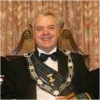
Kenneth C. Jack FPS is an enthusiastic Masonic researcher/writer from Highland Perthshire in Scotland.
He is Past Master of a Craft Lodge, Past First Principal of a Royal Arch Chapter, Past Most-Wise Sovereign of a Sovereign Chapter of Princes Rose Croix.
He has been extensively published in various Masonic periodicals throughout the world including: The Ashlar, The Square, The Scottish Rite Journal, Masonic Magazine, Philalethes Journal, and the annual transactions of various Masonic bodies.
Kenneth is a Fellow of the Philalethes Society, a highly prestigious Masonic research body based in the USA.
Recent Articles: Kenneth C. Jack
 Observations on the History of Masonic Research Archaeology is often associated with uncovering ancient tombs and fossilized remains, but it goes beyond that. In a Masonic context, archaeology can be used to study and analyze the material culture of Freemasonry, providing insight into its history and development. This article will explore the emergence and evolution of Masonic research, shedding light on the challenges faced by this ancient society in the modern world. |
 Anthony O'Neal Haye – Freemason, Poet, Author and Magus Discover the untold story of Anthony O’Neal Haye, a revered Scottish Freemason and Poet Laureate of Lodge Canongate Kilwinning No. 2 in Edinburgh. Beyond his Masonic achievements, Haye was a prolific author, delving deep into the history of the Knights Templar and leaving an indelible mark on Scottish Freemasonry. Dive into the life of a man who, despite his humble beginnings, rose to prominence in both Masonic and literary circles, leaving a legacy that continues to inspire. |
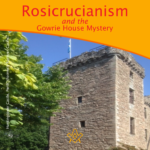 Rosicrucianism and the Gowrie House Mystery Unearth the mystifying intersections of Rosicrucianism and the infamous Gowrie House Mystery. Dive into speculative claims of sacred knowledge, royal theft, and a Masonic conspiracy, harking back to a fateful day in 1600. As we delve into this enthralling enigma, we challenge everything you thought you knew about this historical thriller. A paper by Kenneth Jack |
 Thomas Telford's Masonic Bridge of Dunkeld Of course, there is no such thing as a ‘Masonic Bridge’; but if any bridge is deserving of such an epithet, then the Bridge of Dunkeld is surely it. Designed by Scotsman Thomas Telford, one of the most famous Freemasons in history. |
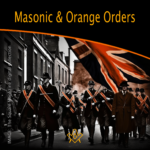 The masonic and orange orders: fraternal twins or public misperception? “Who’s the Mason in the black?” |
 Kenneth Jack's research reveals James Murray, 2nd Duke of Atholl – the 'lost Grand Master' |
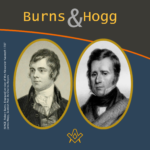 An Oration delivered to the Annual Burns and Hogg Festival, at Lodge Canongate Kilwinning, No. 2, Edinburgh, on 24 January 2018. By Bro. Kenneth C. Jack, FSAScot FPS, Past Master, Lodge St. Andrew, No. 814, Pitlochry. |
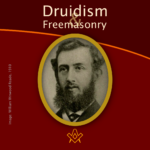 William Winwood Reade was a Scottish philosopher, historian, anthropologist, and explorer born in Crieff, Perthshire, Scotland. The following article by Kenneth Jack, provides some hints that William may have been a Freemason, but there is presently no definitive evidence he was. |
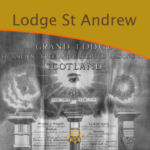 What's in a name? A brief history of the first Scottish Lodge in Australia - By Brother Kenneth C. Jack, Past Master, Lodge St. Andrew, No. 814, Pitlochry |
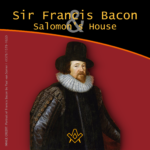 Sir Francis Bacon and Salomon’s House Does Sir Francis Bacon's book "The New Atlantis" indicate that he was a Rosicrucian, and most likely a Freemason too? Article by Kenneth Jack |
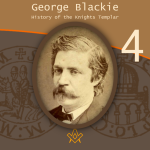 George Blackie – The History of the Knights Templar P.4 The final part in the serialisation of George Blackie's 'History of the Knights Templar and the Sublime Teachings of the Order' transcribed by Kenneth Jack. |
 George Blackie – The History of the Knights Templar P.3 Third part in the serialisation of George Blackie's 'History of the Knights Templar and the Sublime Teachings of the Order' transcribed by Kenneth Jack. |
 George Blackie – The History of the Knights Templar P.2 Second part in the serialisation of George Blackie's 'History of the Knights Templar and the Sublime Teachings of the Order' transcribed by Kenneth Jack. |
 George Blackie – The History of the Knights Templar P.1 First part in the serialisation of George Blackie's History of the Knights Templar and the Sublime Teachings of the Order – by Kenneth Jack |
 Little known as a Freemason, Bro Dr Robert ‘The Bulldog’ Irvine remains a Scottish rugby legend, and his feat of appearing in 10 consecutive international matches against England has only been surpassed once in 140 years by Sandy Carmichael. |
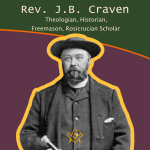 Rev. J.B. Craven: Theologian, Historian, Freemason, And Rosicrucian Scholar Archdeacon James Brown Craven is one of those unsung heroes of Scottish Freemasonry about whom very little has been previously written – here Kenneth Jack explores the life and works of this remarkable esoteric Christian. |
 Discover the powerful family of William Schaw, known as the 'Father of Freemasonry' |
 This month, Kenneth Jack invites us to look at the life of Sir William Peck; - astronomer, Freemason and inventor of the world's first electric car. A truly fascinating life story. |
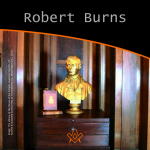 A Tribute to Scotland's Bard – The William Robertson Smith Collection With Burns' Night approaching, we pay tribute to Scotland's most famous Bard – The William Robertson Smith Collection |
 The Joy of Masonic Book Collecting Book purchasing and collecting is a great joy in its own right, but when a little extra something reveals itself on purchase; particularly with regards to older, rarer titles.. |
 Masons, Magus', and Monks of St Giles - who were the Birrell family of Scottish Freemasonry? |
 The 6th Duke of Atholl - Chieftain, Grand Master, and a Memorial to Remember In 1865, why did over 500 Scottish Freemasons climb a hill in Perthshire carrying working tools, corn, oil and wine? Author Kenneth Jack retraces their steps, and reveals all. |
 Charles Mackay: Freemason, Journalist, Writer Kenneth Jack looks at life of Bro Charles Mackay: Freemason, Journalist, Writer, Poet; and Author of ‘Tubal Cain’. |
 A Mother Lodge and a Connection Uncovered, a claim that Sir Robert Moray was the first speculative Freemason to be initiated on English soil. |
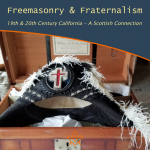 What is it that connects a very old, well-known Crieff family, with a former President of the United States of America? |
 The life of Bro. Cattanach, a theosophist occultist and Scottish Freemason |
 The Mysterious Walled Garden of Edzell Castle Explore the mysterious walled garden steeped in Freemasonry, Rosicrucianism, and Hermeticism. |
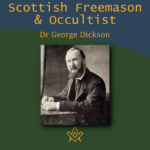 Dr. George Dickson: Scottish Freemason and Occultist Bro. Kenneth explores the life of Dr George Dickson a Scottish Freemason and Occultist |
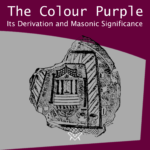 The Colour Purple - Its Derivation and Masonic Significance What is the colour purple with regards to Freemasonry? The colour is certainly significant within the Royal Arch series of degrees being emblematical of Union. |
 Bridging the Mainstream and the Fringe Edward MacBean bridging mainstream Freemasonry with the fringe esoteric branches of Freemasonry |
 Freemasonry in the Works of John Steinbeck We examine Freemasonry in the Works of John Steinbeck |
 Renegade Scottish Freemason - John Crombie Who was John Crombie and why was he a 'renegade'? |
 Scottish Witchcraft And The Third Degree How is Witchcraft connected to the Scottish Third Degree |
masonic knowledge
to be a better citizen of the world
share the square with two brothers

click image to open email app on mobile device
